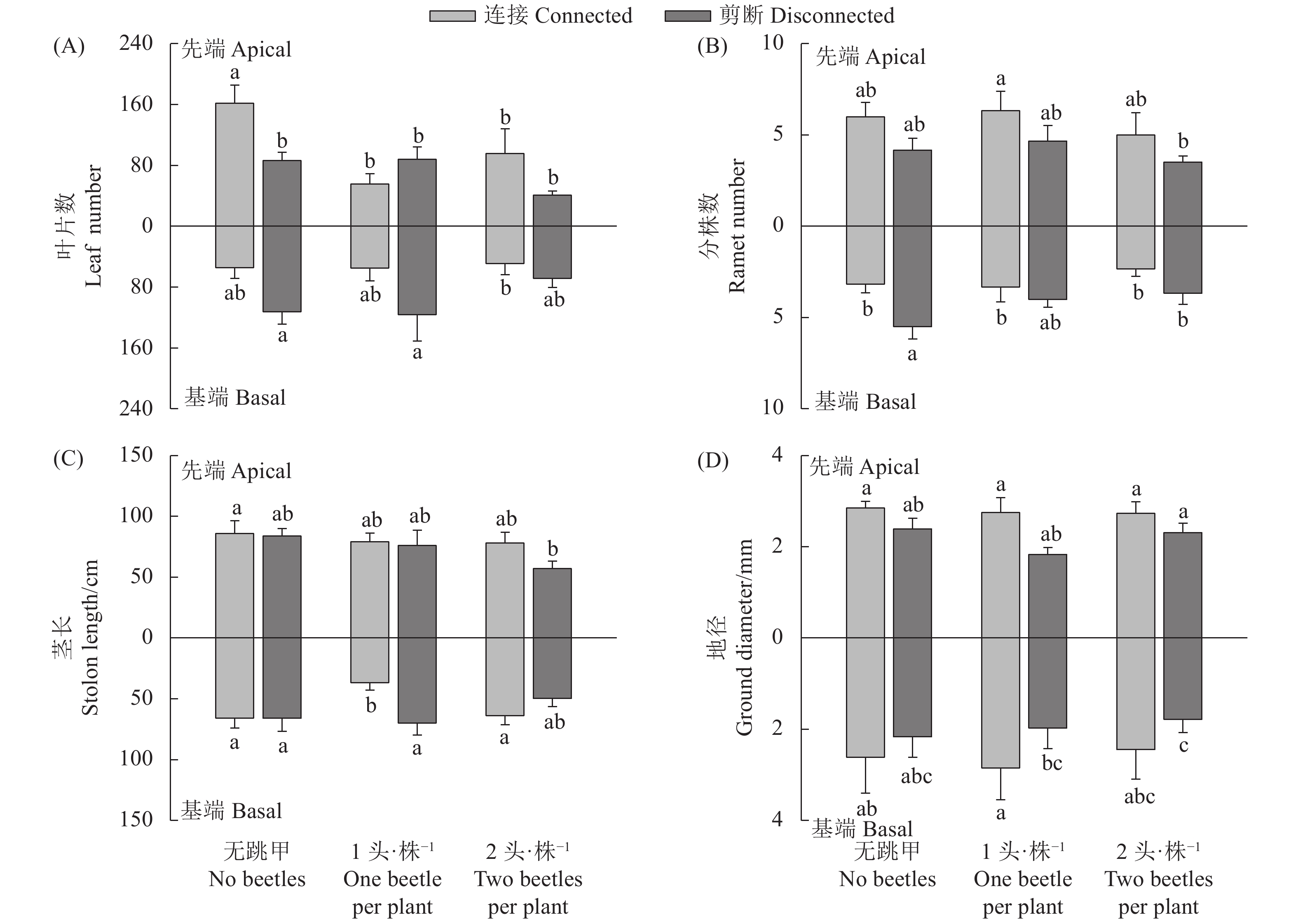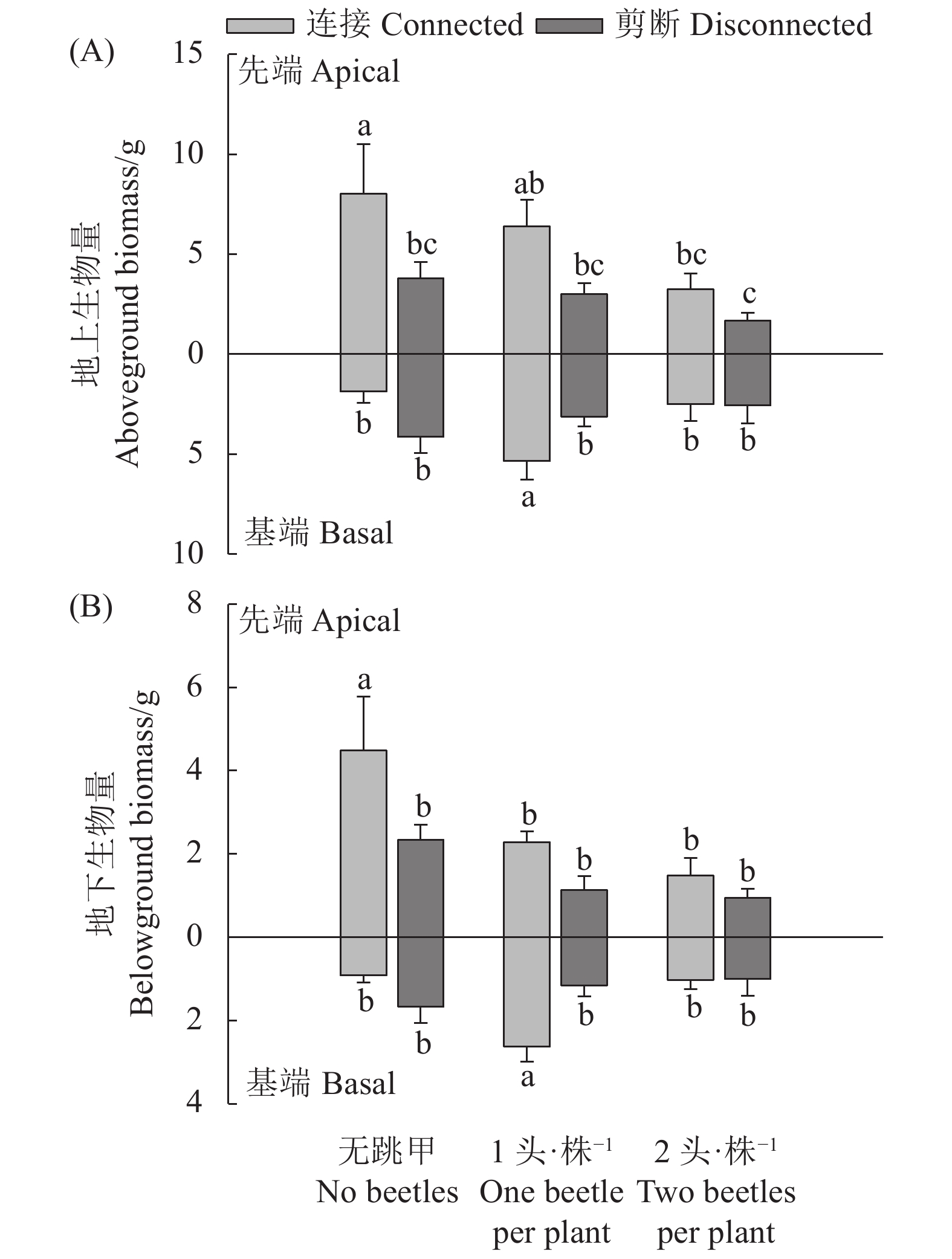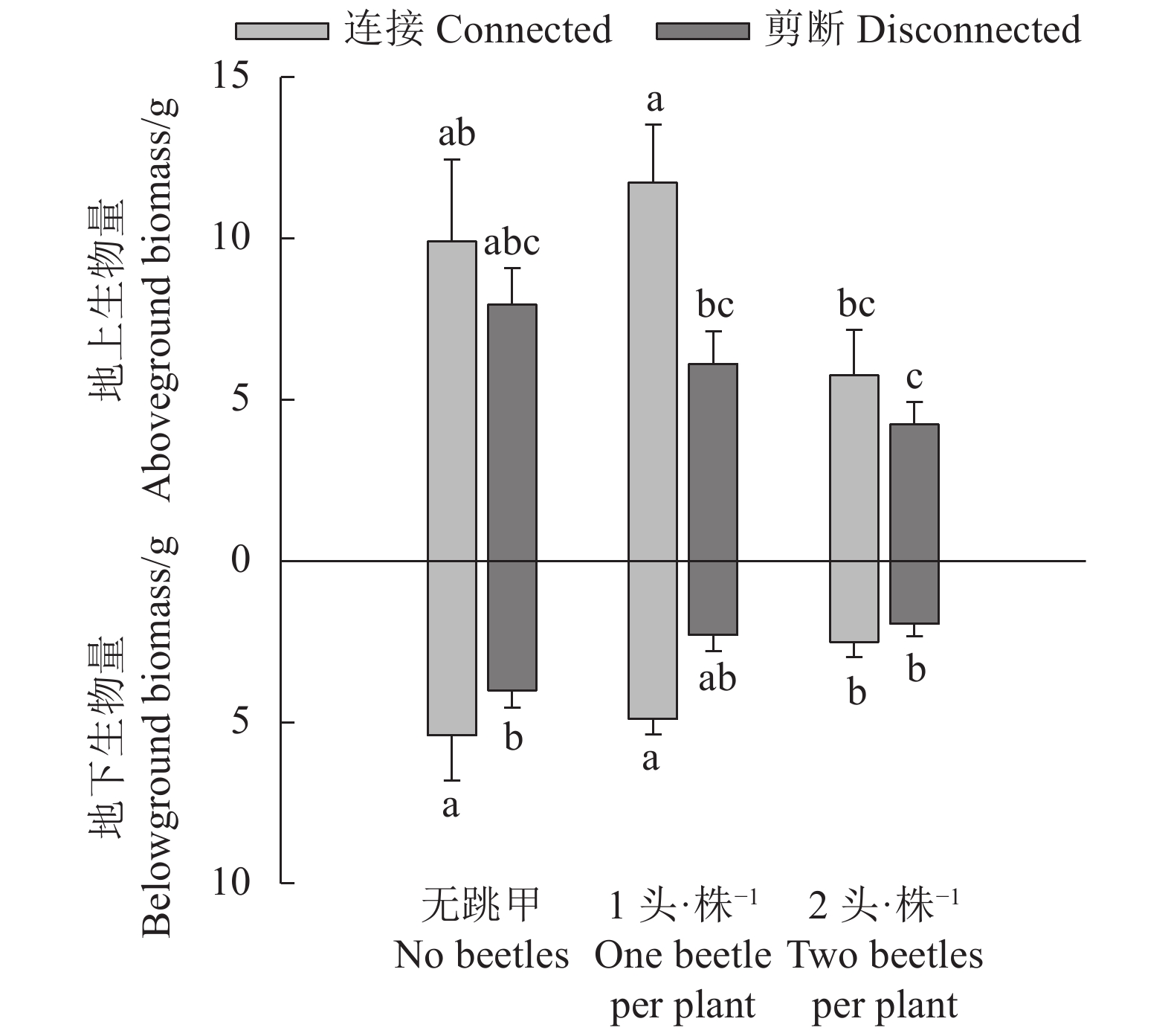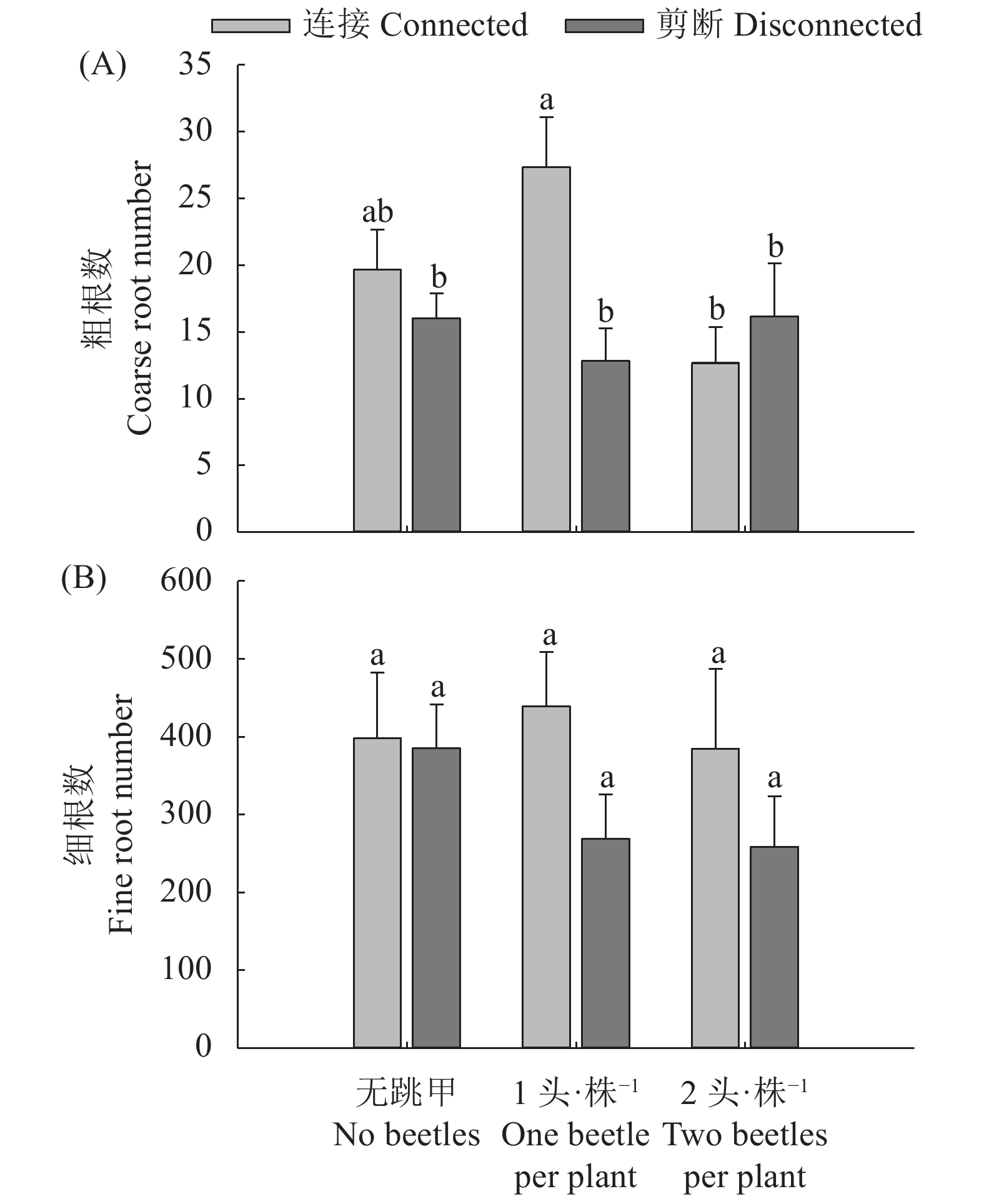Clonal Integration of Alternanthera philoxeroides Affected by Agasicles hygrophila Population
-
摘要:目的
探明莲草直胸跳甲取食密度对空心莲子草克隆整合能力的影响,为空心莲子草的防治提供依据。
方法以入侵植物空心莲子草为研究对象,通过同质园试验,比较在不同莲草直胸跳甲取食密度下(无取食、1头·株−1或2头·株−1)、有无克隆整合对空心莲子草先端分株、基端分株及整个克隆片段地上部分生长特性、根系生长及生物量分配的影响差异。
结果与无跳甲取食相比,有跳甲取食的空心莲子草先端分株的叶片数、地上生物量、地下生物量、总生物量、粗根数以及整个克隆片段的地下生物量均显著降低。有克隆整合的空心莲子草先端分株的叶片数、粗根数、总根数、地上生物量、地下生物量、总生物量和基端分株的地径,以及整个克隆片段的地径、地上生物量、地下生物量、总生物量与无克隆整合的相比均显著增加。在较低密度(1头·株−1)莲草直胸跳甲取食下,有克隆整合的空心莲子草先端分株的粗根数和基端分株的地径及整个克隆片段的地径、粗根数、地上生物量与无克隆整合相比均显著增加;然而,在高密度(2头·株−1)莲草直胸跳甲取食下,有克隆整合的空心莲子草先端分株和基端分株的地径、粗根数、地上生物量与无克隆整合的相比无显著差异,整个克隆整合片段的叶片数、茎长、地径与无克隆整合的相比显著增加。
结论莲草直胸跳甲取食密度对空心莲子草的克隆整合能力产生显著影响:在无天敌取食或较低密度(1头·株−1)的天敌取食下,空心莲子草能通过克隆整合显著获益;但高密度(2头·株−1)莲草直胸跳甲能极大减弱空心莲子草的克隆整合能力,从而实现莲草直胸跳甲对空心莲子草的有效生物防治。
Abstract:ObjectiveClonal integration of alligator weed (Alternanthera philoxeroid) affected by the density of flea beetles (Agasicles hygrophila) population on site was studied to understand how the plants alleviate feeding pressure of the natural enemy.
MethodsIn a field study on gardens of similar properties, A. philoxeroides was exposed to A. hygrophila in varying population densities (no beetles, one beetle per weed plant or two beeltes per weed plant) to examine the clonal integration of the weed in response. Plant and root growth, apical and basal ramets biomasses, and clonal fragment of the weed were monitored.
ResultsThe aboveground, belowground, and total biomasses, the counts of leaves and thick roots of apical ramets, and the belowground biomass of entire clonal fragment of the alligator weed on the field under herbivory of A. hygrophila were significantly lower than that free of the beetles. The numbers of leaves, thick roots, and total roots and the above-, belowground, and total biomasses of apical ramets, the diameters of basal ramets and belowground stem, the above-, belowground, and total biomasses of entire clonal fragment of the alligator weed were significantly higher with the existence of the clonal integration than without. In the presence of one beetle per weed plant, the number of thick apical ramet roots, belowground stem girth of basal ramets, and belowground stem girth, thick root count, and aboveground biomass of entire clonal fragment of the weed were significantly higher with clonal integration than without. However, when the density of the beetles increased to two on a plant with clonal integration, even though no significant differences in the belowground stem diameter, thick root count, and aboveground biomass of apical and basal ramets, the leaf count, stem length, and belowground stem girth of the entire clonal fragment were significantly greater than the weed with no clonal integration.
ConclusionThe density of A. hygrophila presented in an alligator weed growing area significantly affected the capacity of the weed clonal integration to curtail the feeding by the beetles. The weed could significantly mitigate the herbivorous act with the clone integration when the A. hygrophila population remained relatively low, e.g., one beetle per plant. But as the beetle density increased to two per plant, the effectiveness of the clonal integration of the weed diminished significantly, thereby effective biological control of the alligator weed proliferation could be achieved.
-
伪狂犬病(Pseudorabies,PR)是由疱疹病毒引起的多种家畜和野生动物以发热、奇痒及脑脊髓炎为主要症状的一种疾病[1],该病主要表现为妊娠母猪流产,木乃伊胎和产弱仔,初生仔猪出现腹泻及神经症状高感染率和高死亡率,公猪睾丸炎等,是严重危害养猪业的主要传染病之一。近年来在集约化、规模化猪场,采用伪狂犬基因缺失疫苗进行猪群伪狂犬病防治,得到有效控制[2-3]。但2011年以来,猪伪狂犬病疫情率先在华北暴发,许多使用基因缺失活疫苗免疫的规模化猪场出现了疑似PR流行[4-8]。福建地区猪场也出现大面积感染PR现象,包括免疫伪狂犬病毒(PRV) gE基因缺失疫苗的规模化猪场,阳性率普遍升高,疫情日趋严重。其临床症状为公猪精液质量下降,部分母猪流产、死胎,仔猪顽固性腹泻,保育猪和育肥猪打喷嚏、咳嗽的呼吸道症状,并于2012年从病死猪中分离到一株新型PRV病毒(命名为PRV-FJ2012)[9]。
PRV弱毒FB株是FA株经鸡胚细胞体外培养500代后,再以选斑和低温诱变相结合在原代乳兔肾(RK)细胞上32℃传180代后选育而成的弱毒株,FB株对易感动物(牛、山羊、小猪)不但安全性好,且具有良好的免疫原性;FB与gE基因缺失的Bartha-K61株相比,对家兔致病力更弱、更安全[10-11]。为了评价PRV弱毒FB株预防新型PRV的潜力,应用微量交叉中和试验(NT)比较了4株伪狂犬病毒(FA、FB、Bartha-K61和FJ2012)之间的抗原相关性,通过免疫攻毒保护试验评价FB株对预防新型PRV的潜力,为进一步研究安全有效的疫苗提供依据。
1. 材料与方法
1.1 病毒株和高免血清
PRV FA株[12-13]和FB株[10-14]均由福建省农业科学院畜牧兽医研究所分离鉴定、选育并保存;PRV FJ2012由福建省农业科学院畜牧兽医研究所猪病研究室分离、鉴定并保存[9];兔抗PRV FA、FB、Bartha-K61和FJ2012高免血清由本课题组制备并保存;PRV Bartha-K61株购自中国兽药监察所。
1.2 试验用禽胚、动物及试剂
9日龄SPF鸡胚购自福州大北农生物技术有限公司;12头PRV gB抗体阴性的20日龄仔猪购自福建某健康种猪场;体重2~3 kg雄性新西兰大白兔购自闽侯吴氏实验动物贸易有限公司;羊抗兔酶标二抗购自博士德生物工程有限公司。
1.3 病毒增殖
分别将PRVFJ2012、FA、FB和Bartha-K61株病毒,按维持液量的1%接种于单层CEF细胞瓶,置37℃温箱培养,每日观察细胞病变,当病变达75%收冻于-20℃,冻融3次后,收获细胞毒,-70℃保存备用。
1.4 病毒TCID50测定
将上述病毒用细胞维持液作10倍系列稀释后,接种于已长成单层CEF 96孔细胞培养板,每一个稀释度接种4孔,每孔接毒量100 μL,并设对照,37℃、6% CO2培养箱培养,每天观察细胞病变情况并记录,一直观察至7 d,出现CPE者判为感染,按Reed-Muench法计算TCID50。
1.5 微量中和试验
在96孔CEF单层细胞板上按固定病毒-稀释血清法进行中和试验。先将兔抗PRV高免血清(FJ2012ab、FAab、FBab和Bartha-K61ab),经56℃水浴作用30 min后进行2倍比系列稀释,分别取不同稀释度血清与200TCID50等量混合,37℃作用1 h,每个稀释度接种4孔CEF单层细胞,每孔100 μL,同时设正常细胞对照、不同毒株的病毒对照。置37℃、6.0% CO2培养箱培养,每天观察细胞病变情况并记录,连续观察至7 d,按Reed-Muench法分别计算各自高免血清的中和抗体效价(PD50)及其与不同毒株间的交叉中和抗体效价。
1.6 抗原相关性判定标准[15]
根据公式R=√r1⋅r2,计算各病毒株之间的抗原相关性。R为两毒株间抗原性差异,r1为乙血清对甲病毒的抗体效价/甲血清对甲病毒的抗体效价,r2为甲血清对乙病毒的抗体效价/乙血清对乙病毒的抗体效价。当相关系数R>0.8,则两毒株为同一血清型;当相关系数R=0.25~0.80时,两毒株为同一血清型不同亚型;当相关系数R < 0.25,则两毒株为不同血清型;R值越小则病毒株之间抗原性差异越大。
1.7 易感仔猪免疫攻毒试验
20日龄PRV gB抗体阴性健康易感仔猪13头随机分成免疫组、对照组和健康组。其中,免疫组5头,每头肌注FB株细胞毒与英特威佐剂1: 1混合液2 mL(免疫剂量为105.5TCID50),对照组5头,每头肌注Hank′s与英特威佐剂1: 1混合液2 mL,健康组3头不注射。各组隔离饲养,并于免疫后20 d,取免疫组和对照组分别攻毒,每头肌注PRV-FJ2012株2 mL(攻毒剂量106.5TCID50),观察30 d记录发病和死亡情况,评价PRV FB株对新型PRV FJ2012株的保护效果。
2. 结果与分析
2.1 病毒增殖和TCID50测定
病毒按接毒量1%接种于单层CEF细胞瓶后,第2 d出现散在的病灶,即细胞肿胀和圆缩,随后逐渐扩展,直至全部细胞溶解脱落,FA、FJ2012和Bartha-K61毒株均出现大量巨融合细胞病变,而FB毒株的CPE表现为细胞圆缩而无巨融合细胞现象。PRV FJ2012株、FA株、FB株和Bartha-K61株每毫升病毒含量分别为106.5 TCID50、106.25 TCID50、106.0 TCID50和106.75 TCID50。
2.2 兔抗PRV高免血清效价测定
按固定病毒稀释血清法,测定兔抗FJ2012ab、FAab、FBab和Bartha-K61ab高免血清与同源病毒之间的中和效价分别为26.5(1: 91)、26.5(1: 91)、25.75(1: 54)和27.75(1: 215);高免血清与同源病毒的中和效价均不同程度高于其与异源病毒的中和效价(表 1)。
表 1 4株PRV交叉中和抗体效价及其抗原相关性R值Table 1. VN antibodies and correlation coefficients on antigens of 4 strains of PRV病毒株 高免血清* R值 FAab FBab Bartha-K61ab FJ2012ab FA FB Bartha-K61 FJ2012 FA 6.5 5.5 5.25 6.5 1 FB 6.25 5.75 5.0 6.5 0.84 1 Bartha-K61 6.25 5.25 7.75 5.5 0.39 0.32 1 FJ2012 6.25 5.5 5.5 6.5 0.92 0.92 0.32 1 *注:表中中和抗体数据为-lg2值。 2.3 4种伪狂犬病毒抗原相关性R值测定
从表 1可知,FA株与FB株、FA株与FJ2012株、FB株与FJ2012株的抗原相关R值分别为0.84、0.92和0.92,即FB株与FA株或FJ2012株之间的抗原相关性大,抗原差异小;Bartha-K61株与FA株、FB株、FJ2012株的抗原相关R值分别为0.39、0.32和0.32,即Bartha-K61株与FA株或FJ2012株在抗原性上存在较大差异;表明弱毒FB株与新型PRV FJ2012株的抗原相关性高于Bartha-K61株与FJ2012株,从抗原性方面提示PRV FB株有望成为预防新型PRV(FJ2012株)的活疫苗候选株。
2.4 易感仔猪FB株免疫攻毒结果
40日龄对照组仔猪肌注新型PRV FJ2012株强毒,于PI 24 h对照攻毒猪出现精神沉郁和食欲减少,并逐渐加重,PI 36 h后全部开始出现喘气、流涏、体温达41℃,喘气和发热一直持续12 d,病猪明显消瘦,其间死亡2头,随后缓慢恢复,观察30 d的发病率100%,死亡率40%(表 2)。而20日龄健康易感仔猪免疫PRV FB株毒后20 d进行攻毒,肌注感染新型PRV FJ2012株强毒,免疫猪攻毒后24 h出现一过性精神沉郁和采食量减少但第二天即恢复正常,观察30 d免疫攻毒组均未出现消瘦和死亡,免疫猪的攻毒保护率100%(5/5)(表 2);表明PRV FB株免疫猪能抵抗FJ2012株的攻击,FB株有望成为预防新型PRV的候选疫苗株。
表 2 仔猪FB株免疫后对新型PRV FJ 2012株的攻毒保护结果Table 2. Viral challenge test of FB on preventing PRV FJ2012 infection组别 数量/头 免疫剂量 攻毒日龄/d 攻毒剂量 发病率/% 死亡率/% 免疫攻毒组 5 105.5TCID50 40 106.5TCID50 0 0 对照攻毒组 5 0 40 106.5TCID50 100 40 健康对照组 3 0 40 0 0 0 3. 讨论与结论
PRV FB株是由福建省农业科学院畜牧兽医研究所选育致弱而成,FB株接种仔猪既能刺激机体产生中和抗体,又能产生细胞免疫,且免疫后60 d仍维持较高水平[16]。魏振明等[17]以FB株免疫怀孕后期母猪,可使乳猪从初乳中吸收高浓度抗体而获得被动免疫,即FB株对怀孕后期母猪和乳猪均安全有效。以PRV FB免疫130日龄猪,免疫后4d血清中和抗体指数为(1.9 Lg),免疫后21 d形成峰值(3.5 Lg),并且能够通过母乳使仔猪得到被动保护,而Bartha-K61株免疫猪的血清中和抗体低下,却有保护作用,即机体产生细胞免疫,提示PRV FB与Bartha-K61株之间存在免疫生物学的差异[16]。
程由铨等[18]应用单克隆抗体(McAb)对FB和Bartha-K61株的免疫印迹分析发现,McAbl0只识别FB的105 kD多肽,不识别Bartha-K61株的多肽;该结果与ELISA结果(McAb10只与FA和FB反应,而不与Bartha-K61株反应)相吻合,也证明了PRV不同毒株抗原结构上存在差异。彭金美等[6]采用固定病毒稀释血清法测定了Bartha-K61和PRV新流行毒HeN1株抗血清之间的交叉中和抗体,发现PRV流行毒株(HeN1株)与疫苗株(Bartha-K61株)之间的抗原性存在一定差异。FJ2012株分离自福建省PR病猪群,该分离株不仅可以导致母猪流产,还可以引起中大猪发病,通过全基因组测序并与经典毒株比较发现FJ2012毒株存在基因变异[9]。本研究结果发现抗PRV高免血清与同源PRV病毒的中和效价均不同程度高于异源PRV病毒,抗原相关性R值也存在明显差异,且FB株和新型PRV FJ2012株的抗原相关性R值高于Bartha-K61株与FJ2012株的R值,而且对FB免疫猪的攻毒保护试验结果也发现FB株免疫易感仔猪能有效抵抗新型PRV(FJ2012株)的攻毒。以上结果表明PRV不同毒株之间存在抗原性差异,PRV FB株与新型PRV FJ2012株的抗原相关性更高,提示PRV FB株有望成为预防新型PRV(FJ2012株)的疫苗候选株,但FB株对FJ 2012强毒株免疫保护的最小免疫剂量、免疫产生期和持续期等还需进一步测定。
-
图 1 莲草直胸跳甲取食密度及克隆整合对空心莲子草先端分株和基端分株地上部分生长特性的影响
不同小写字母表示不同处理下的先端分株或基端分株生长指标差异显著(P < 0.05),下同。
Figure 1. Effects of density of A. hygrophila and clonal integration of alligator weed on aboveground growth of apical and basal ramets of alligator weed
Data with different lowercase letters indicate significant differences on growth traits of apical or basal ramets under different treatments at P<0.05. Same for below.
表 1 莲草直胸跳甲取食密度与克隆整合对空心莲子草先端分株生长特性的影响
Table 1 Effect of density of A. hygrophila and clonal integration of alligator weed on growth of apical ramets of alligator weed
生长特性
Growth traits跳甲取食密度
Flea beetle density(F2,30)克隆整合
Clonal integration(F1,30)跳甲取食密度×克隆整合
Flea beetle density × clonal integration(F2,30)叶片数 Leaf number 5.26* 4.28* 4.43* 分株数 Ramet number 1.10 5.64* 0.02 茎长 Stolon length 1.93 1.51 0.73 地径 Ground diameter 1.07 10.50** 0.74 粗根数 Coarse root number 7.57** 18.77** 4.99* 细根数 Fine root number 0.23 7.13* 0.85 总根数 Total root number 0.16 7.75** 0.75 地上生物量 Aboveground biomass 3.84* 8.86** 0.57 地下生物量 Belowground biomass 7.42** 6.80* 0.93 总生物量 Total biomass 5.28* 9.36** 0.75 “*”和“**”分别表示在P<0.05和P<0.01水平下差异显著,下同。
* and * * indicate significant differences at P<0.05 and P<0.01, respectively. Same for below.表 2 莲草直胸跳甲取食密度与克隆整合对空心莲子草基端分株生长特性的影响
Table 2 Effects of density of A. hygrophila and clonal integration of alligator weed on growth of basal ramets of alligator weed
生长特性
Growth traits跳甲取食密度
Flea beetle density(F2,30)克隆整合
Clonal integration(F1,30)跳甲取食密度×克隆整合
Flea beetle density × clonal integration(F2,30)叶片数 Leaf number 1.17 8.38** 0.70 分株数 Ramet number 2.57 9.04** 1.02 茎长 Stolon length 1.26 0.93 4.34* 地径 Ground diameter 0.97 11.69** 0.42 粗根数 Coarse root number 0.01 0.09 1.67 细根数 Fine root number 1.50 0.16 3.37* 总根数 Total root number 1.40 0.16 3.37* 地上生物量 Aboveground biomass 2.54 0.00 4.18* 地下生物量 Belowground biomass 4.03* 0.88 6.31** 总生物量 Total biomass 3.55* 0.07 5.71** 表 3 莲草直胸跳甲取食密度与克隆整合对空心莲子草整个克隆片段生长特性的影响
Table 3 Effects of density of A. hygrophila and clonal integration of alligator weed on growth of entire clonal fragment of alligator weed
生长特性
Growth traits跳甲取食密度
Flea beetle density(F2,30)克隆整合
Clonal integration(F1,30)跳甲取食密度×克隆整合
Flea beetle density × clonal integration(F2,30)叶片数 Leaf number 3.69* 0.32 2.73 分株数 Ramet number 2.73 0.07 0.28 茎长 Stolon length 3.35* 0.07 4.67* 地径 Ground diameter 0.67 20.27** 0.94 粗根数 Coarse root number 1.76 3.87 4.43* 细根数 Fine root number 0.45 2.89 0.60 总根数 Total root number 0.48 3.09 0.64 地上生物量 Aboveground biomass 6.05** 6.79* 1.04 地下生物量 Belowground biomass 4.28* 5.78* 1.04 总生物量 Total biomass 5.53** 7.36* 1.23 -
[1] 赵鲁青, 李德志, 李立科, 等. 基于复合节间组分关系的结缕草克隆植株形态可塑性特征分析 [J]. 生态环境学报, 2010, 19(11):2592−2599. ZHAO L Q, LI D Z, LI L K, et al. Analysis on the characteristics of morphological plasticity of a clonal plant Zoysia japonica based on the relationship among the components of multiple-nodes [J]. Ecology and Environmental Sciences, 2010, 19(11): 2592−2599. (in Chinese)
[2] LIU J, DONG M, MIAO S L, et al. Invasive alien plants in China: Role of clonality and geographical origin [J]. Biological Invasions, 2006, 8(7): 1461−1470. DOI: 10.1007/s10530-005-5838-x
[3] LIU J S, CHEN C, PAN Y, et al. The intensity of simulated grazing modifies costs and benefits of physiological integration in a rhizomatous clonal plant [J]. International Journal of Environmental Research and Public Health, 2020, 17(8): 2724. DOI: 10.3390/ijerph17082724
[4] KOWARIK I, LIU J, CHEN H, et al. Plant invasions in China: An emerging hot topic ininvasion science [J]. NeoBiota, 2012, 15: 27−51. DOI: 10.3897/neobiota.15.3751
[5] WANG P, ALPERT P, YU F H. Physiological integration can increase competitive ability in clonal plants if competition is patchy [J]. Oecologia, 2021, 195(1): 199−212. DOI: 10.1007/s00442-020-04823-5
[6] 方龙香, 吕晓倩, 奚道国, 等. 克隆整合有利于喜旱莲子草(Alternanthera philoxeroides)入侵 [J]. 湖泊科学, 2017, 29(5):1202−1208. DOI: 10.18307/2017.0518 FANG L X, LV X Q, XI D G, et al. Clonal integration facilitating for the invasion of Alternanthera philoxeroides [J]. Journal of Lake Sciences, 2017, 29(5): 1202−1208. (in Chinese) DOI: 10.18307/2017.0518
[7] 肖梦婷, 江梦含, 陈明茹, 等. 克隆整合特性和磷素对喜旱莲子草富集土壤中镉的影响 [J]. 武汉大学学报(理学版), 2022, 68(6):603−611. XIAO M T, JIANG M H, CHEN M R, et al. Effects of clonal integration characteristics and phosphorus on cadmium accumulation in soil by Alternanthera philoxeroides [J]. Journal of Wuhan University (Natural Science Edition), 2022, 68(6): 603−611. (in Chinese)
[8] YOU W H, YU D, LIU C H, et al. Clonal integration facilitates invasiveness of the alien aquatic plant Myriophyllum aquaticum L. under heterogeneous water availability [J]. Hydrobiologia, 2013, 718(1): 27−39. DOI: 10.1007/s10750-013-1596-4
[9] 孙凯, 杨丽娟, 蔡竟芳, 等. 施氮形态与分株损伤对入侵植物香菇草生长及克隆整合的影响 [J]. 植物保护, 2022, 48:169−178. SUN K, YANG L J, CAI J F, et al. Effects of nitrogen supply forms and ramets damage on the growth and clonal integration of invasive plant Hydrocotyle vulgaris [J]. Plant Protection, 2022, 48: 169−178. (in Chinese).
[10] DONG B C, ZHANG L M, LI K Y, et al. Effects of clonal integration and nitrogen supply on responses of a clonal plant to short-term herbivory [J]. Journal of Plant Ecology, 2019, 12(4): 624−635. DOI: 10.1093/jpe/rty057
[11] 宋誉, 郭文锋, 李晓琼. 克隆整合对入侵杂草空心莲子草和本土莲子草生长及光合性能的影响 [J]. 华南农业大学学报, 2023, 44(4):531−538. SONG Y, GUO W F, LI X Q. Effects of clonal integration on growth and photosynthesis of invasive weed Alternanthera philoxeroides and native A. sessilis [J]. Journal of South China Agricultural University, 2023, 44(4): 531−538. (in Chinese)
[12] WEI Q, LI Q, JIN Y, et al. Effects of clonal integration on photochemical activity and growth performance of stoloniferous herb Centella asiatica suffering from heterogeneous water availability [J]. Flora, 2019, 256: 36−42. DOI: 10.1016/j.flora.2019.05.001
[13] 辜睿, 蒲磊, 李军亚, 等. 番茄对不同养分水平下南美蟛蜞菊和蟛蜞菊化感作用的响应 [J]. 广西植物, 2021, 41:1354−1362. GU R, PU L, LI J Y , et al. Allelopathic effects of Sphagneticola trilobata and S. calendulacea on Lycopersicon esculentum under different nutrient availabilities [J]. Guihaia, 2021, 41: 1354−1362. (in Chinese).
[14] 覃海蓉, 郭文锋, 王伟, 等. 莲草直胸跳甲取食对空心莲子草和莲子草克隆整合的影响[J]. 应用生态学报, 2022, 33: 1661-1668. QIN H R, GUO W F, WANG W, et al. Effects of Agasicles hygrophila herbivory on the clonal integration of Alternanthera philoxeroides and A. sessilis [J]. Chinese Journal of Applied Ecology, 2022, 33: 1661-1660. (in Chinese).
[15] 郭伟, 李钧敏, 胡正华. 酸雨和采食模拟胁迫下克隆整合对空心莲子草生长的影响 [J]. 生态学报, 2012, 32(1):151−158. DOI: 10.5846/stxb201011031575 GUO W, LI J M, HU Z H. Effects of clonal integration on growth of Alternanthera philoxeroides under simulated acid rain and herbivory [J]. Acta Ecologica Sinica, 2012, 32(1): 151−158. (in Chinese) DOI: 10.5846/stxb201011031575
[16] 马瑞燕, 王韧. 喜旱莲子草在中国的入侵机理及其生物防治 [J]. 应用与环境生物学报, 2005, 11(2):246−250. MA R Y, WANG R. Invasive mechanism and biological control of alligatorweed, Alternanthera philoxeroides (Amaranthaceae), in China [J]. Chinese Journal of Applied and Environmental Biology, 2005, 11(2): 246−250. (in Chinese)
[17] 韩翠敏, 胡安安, 郭文兵, 等. 南方菟丝子寄生对入侵植物喜旱莲子草及其近缘种的影响 [J]. 植物研究学, 2020, 9:374. DOI: 10.12677/BR.2020.94046 HAN C M, HU A A, GUO W B, et al. Effects of parasitism of Cuscuta australis on the growth performance of Alternanthera philoxeroides and its related specie [J]. Botanical Research, 2020, 9: 374. (in Chinese). DOI: 10.12677/BR.2020.94046
[18] 苏田, 吴姝瑾, 胡姝珍, 等. 外来种空心莲子草的入侵及其克隆特性综述 [J]. 南方林业科学, 2021, 49(1):44−47,54. SU T, WU S J, HU S Z, et al. Advance in invasion and clonal characteristics of the alien species Alternanthera philoxeroides [J]. South China Forestry Science, 2021, 49(1): 44−47,54. (in Chinese)
[19] PORTELA R, DONG B C, YU F H, et al. Effects of physiological integration on defense strategies against herbivory by the clonal plant Alternanthera philoxeroides [J]. Journal of Plant Ecology, 2019, 12(4): 662−672. DOI: 10.1093/jpe/rtz004
[20] WANG Y J, MÜLLER-SCHÄRER H, VAN KLEUNEN M, et al. Invasive alien plants benefit more from clonal integration in heterogeneous environments than natives [J]. The New Phytologist, 2017, 216(4): 1072−1078. DOI: 10.1111/nph.14820
[21] DONG B C, WANG M Z, LIU R H, et al. Direct and legacy effects of herbivory on growth and physiology of a clonal plant [J]. Biological Invasions, 2018, 20(12): 3631−3645. DOI: 10.1007/s10530-018-1801-5
[22] QIN H R, GUO W F, LI X Q. Density-dependent interactions between the nematode Meloidogyne incognita and the biological control agent Agasicles hygrophila on invasive Alternanthera philoxeroides and its native congener Alternantera sessilis [J]. BioControl, 2021, 66(6): 837−848. DOI: 10.1007/s10526-021-10113-7
[23] 黄思娣. 莲草直胸跳甲对空心莲子草的控制研究[D]. 长沙: 湖南农业大学, 2010. HUANG S D. Controlling effects of Agasicles hygrophila on Alternanthera philoxeroides [D]. Changsha: Hunan Agricultural University, 2010. (in Chinese)
[24] 马瑞燕, 丁建清, 李佰铜, 等. 莲草直胸跳甲在不同生态型空心莲子草上的化蛹适应性 [J]. 中国生物防治, 2003, 19(2):54−58. MA R Y, DING J Q, LI B T, et al. The pupation adaptability of Agasicles hygrophila on different ecotypes alligatorweed [J]. Chinese Journal of Biological Control, 2003, 19(2): 54−58. (in Chinese)
[25] 陈燕丽, 陈中义. 陆生型空心莲子草根的生长动态研究 [J]. 江西农业学报, 2011, 23(2):111−114. CHEN Y L, CHEN Z Y. Study on growth dynamics of roots of terrestrial-type Alternanthera philoxeroides [J]. Acta Agriculturae Jiangxi, 2011, 23(2): 111−114. (in Chinese)
[26] 李彦宁, 傅建炜, 郭建英, 等. 莲草直胸跳甲释放量对其种群构建的影响 [J]. 生物安全学报, 2011, 20(4):275−280. LI Y N, FU J W, GUO J Y, et al. Effects of release density on the population dynamics of the biocontrol agent, Agasicles hygrophila (Coleoptera: Chrysomelidae) [J]. Journal of Biosafety, 2011, 20(4): 275−280. (in Chinese)
[27] 宋振, 张瑞海, 张国良, 等. 空心莲子草叶甲释放量对空心莲子草防控效果的研究 [J]. 生态环境学报, 2018, 27(11):2033−2038. SONG Z, ZHANG R H, ZHANG G L, et al. The effect of Agasicles hygrophila release on the control of Alternanthera philoxeroides [J]. Ecology and Environmental Sciences, 2018, 27(11): 2033−2038. (in Chinese)
[28] 赵浩宇, 刘俊豆, 郑仕军, 等. 空心莲子草综合防治技术 [J]. 四川农业与农机, 2021(2):56−57. ZHAO H Y, LIU J D, ZHENG S J, et al. Integrated control techniques of Alternanthera philoxeroides [J]. Sichuan Agriculture and Agricultural Machinery, 2021(2): 56−57. (in Chinese)
[29] YOU W H, FAN S F, YU D, et al. An invasive clonal plant benefits from clonal integration more than a co-occurring native plant in nutrient-patchy and competitive environments [J]. PLoS One, 2014, 9(5): e97246. DOI: 10.1371/journal.pone.0097246
[30] 陶冶, 张元明. 准噶尔荒漠6种类短命植物生物量分配与异速生长关系 [J]. 草业学报, 2014, 23(2):38−48. TAO Y, ZHANG Y M. Biomass allocation patterns and allometric relationships of six ephemeroid species in Junggar Basin, China [J]. Acta Prataculturae Sinica, 2014, 23(2): 38−48. (in Chinese)
[31] SCHOOLER S S, YEATES A G, WILSON J R U, et al. Herbivory, mowing, and herbicides differently affect production and nutrient allocation of Alternanthera philoxeroides [J]. Aquatic Botany, 2007, 86(1): 62−68. DOI: 10.1016/j.aquabot.2006.09.004
[32] 徐苏男, 刘艳虹, 李虹仪, 等. 养分异质条件下结缕草克隆分株生长、碳水化合物及可溶性蛋白的生理整合 [J]. 应用生态学报, 2018, 29(11):3569−3576. XU S N, LIU Y H, LI H Y, et al. Physiological integration of growth, carbohydrates, and soluble protein of Zoysia japonica clonal ramets under nutrient heterogeneity [J]. Chinese Journal of Applied Ecology, 2018, 29(11): 3569−3576. (in Chinese)
[33] 姜星星, 董必成, 罗芳丽, 等. 光强对比度对大米草克隆整合作用的影响 [J]. 应用生态学报, 2014, 25(10):2826−2832. JIANG X X, DONG B C, LUO F L, et al. Effects of light intensity contrast on clonal integration of Spartina anglica [J]. Chinese Journal of Applied Ecology, 2014, 25(10): 2826−2832. (in Chinese)
[34] 覃海蓉, 郭文锋, 阳莎, 等. 莲草直胸跳甲和根结线虫共同危害对空心莲子草及莲子草生长的影响 [J]. 河南农业大学学报, 2021, 55:890−895. QIN H R, GUO W F, YANG S, et al. Joint herbivory of Agasicles hygrophila and Meloidogyne incognita on the growth of Alternanthera philoxeroides and Alternanthera sessilis [J]. Journal of Henan Agricultural University, 2021, 55: 890−895. (in Chinese).
-
期刊类型引用(1)
1. 万曾培,王征帆,庞旋飞,王凤求,王贵平,李中圣,白挨泉. PRV变异株gB和gC基因分子特征及抗原差异性分析. 中国兽医学报. 2020(08): 1454-1460 .  百度学术
百度学术
其他类型引用(3)




 下载:
下载:






